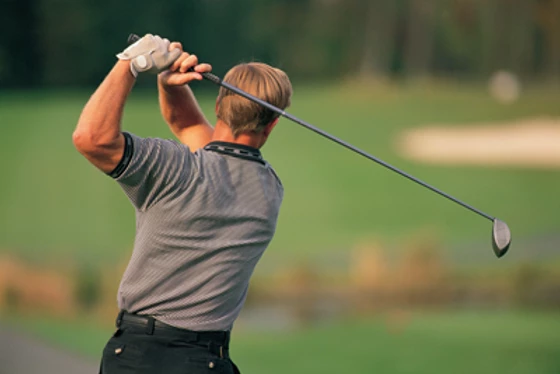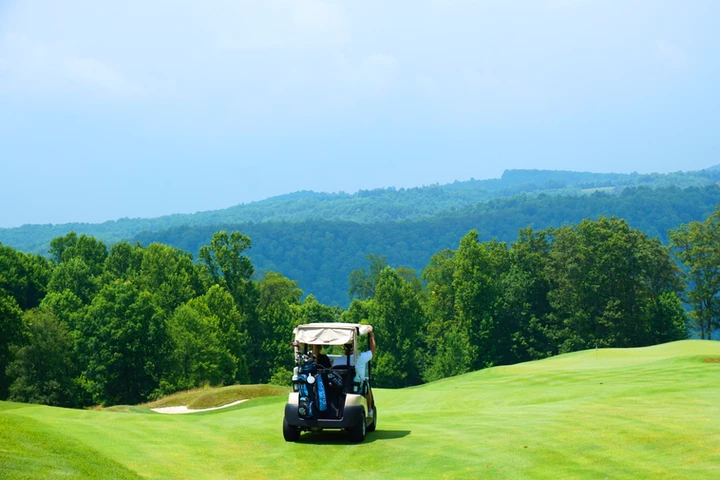- Why Golfers are prone to common injuries due to overuse and repetition, with low back pain, rotator cuff injuries, tennis/golf elbow, wrist tendinitis, and knee pain being prevalent issues.
- What are the proper form and sport-specific training that is essential for injury prevention which includes strengthening core and hip muscles, maintaining flexibility, and seeking professional coaching.
- How the initial treatment if injured involves rest, ice, and anti-inflammatory medication, followed by seeking guidance from a physical therapist for rehabilitation and gradual return to golfing activities.
When it comes to golf, most people assume it to be a slow-paced, low-impact sport. While they’re not wrong, this doesn’t mean that golfers are free from the prospect of injury. Though sometimes inevitable, having a general understanding of common golf injuries can prevent problems from happening and provide you with ideas for sport-specific training away from the golf course.
So, which injuries might occur as a result of a few rounds at your favorite golf courses or even Topgolf?
Aside from a traumatic injury, most golf injuries are related to overuse and repetition. You know, the ones that chronically nag at you and worsen over time. There’s a handful of them that can plague golfers, and knowing about the most common ones, can help you to stay active on the golf course and away from injury.

Common Golf Injuries
- Low Back Pain
As a golfer, you use your low back more than you may realize.
Think about it: A golfer’s stance includes bending at the waist, and a powerful drive requires a large degree of rotation at the torso while both feet are firmly planted. Over time, it’s highly likely that you’re going to experience low back pain, especially if your form could use some work. Improper form, specifically during your swing, and lack of hip flexibility and core strength are major contributors to low back pain on the golf course.
If low back pain is plaguing you, then it’s important that you listen to your body and seek treatment. The sooner you acknowledge it, the less time you spend off the golf course because of it.
Therefore, it should come as no surprise that rest is the best treatment option. Give your body time to heal, and refrain from rotational movements for now. Instead, incorporate a flexibility and stretching program into your workout routine. Pay extra attention to the torso, mid-back, hip flexors, glutes, and hamstrings. When you’re feeling better, make sure to add in low back strengthening and core stabilization exercises.
- Rotator Cuff Injuries
Another big player in common golf injuries is the shoulder. Repetition and improper upper body positioning during your swing can lead to an overuse injury in the shoulder, mainly the rotator cuff. However, the rotator cuff can also be damaged in a more traumatic fashion as well.
The rotator cuff is made up of four muscles (supraspinatus, infraspinatus, teres minor, and the subscapularis) that support and move the shoulder joint. We can distinguish which muscle (or muscles) is injured based on the phase of your swing that causes the most pain.
The number one indicator of a rotator cuff injury is deep, aching pain that occurs at night when you’re inactive. You’ll also notice rotator cuff pain when reaching above your head, across your body, or getting dressed. Rotator cuff injuries also cause limitations in your shoulder range of motion and tenderness at certain points along the shoulder joint.
Depending on the severity of the injury, you may need imaging of your rotator cuff to pinpoint the source of pain. If a tear is present, then there is always a possibility that surgery is needed. Fortunately, most rotator cuff injuries in golf can be treated with anti-inflammatory medication and strengthening those four muscles.
- Tennis Elbow vs Golf Elbow
Elbow tendonitis is another one of those chronic, nagging injuries. It occurs when the tendons on either side of the elbow joint become inflamed and is usually a direct consequence of repetitive motion at the wrist and forearm.
Funny enough, although “golf elbow” was named for medial epicondylitis, those on the golf course more frequently suffer from “tennis elbow,” also known as lateral epicondylitis. And, as expected, golf elbow pain or tennis elbow pain can be exacerbated by an improper golf swing.
Specifically, golf elbow pain results from inflammation of the tendons on the inner part of the elbow, known as the flexor tendons. They connect the muscles of your forearm that flex your wrist to a bony prominence on your humerus called the medial epicondyle.
On the other hand, tennis elbow pain affects the other side (outside) of the elbow. These tendons on this aspect of your elbow are the extensor tendons, and they connect to the lateral epicondyle of your humerus.
Tennis elbow vs golf elbow can be difficult to differentiate because the signs and symptoms are largely the same, aside from the location of the pain. Other things to look out for when distinguishing between tennis elbow, golf elbow, and other injuries are :
Decreased range of motion in the elbow, forearm, or wrist
Tenderness along the elbow
Stiffness in the elbow joint
Possible swelling
Combating tennis elbow or golf elbow pain is pretty cut and dry. Rest, ice, and anti-inflammatory medication are going to be your go-to treatment methods. The body needs time for the inflammation to pass, and those three treatments are the most effective trifecta.
- Tendinitis of the Wrist
As with the elbow, the tendons of the wrist can become inflamed, too. The repetitive motion of the golf swing and high-velocity movements that are placed on the wrist joint is your number one factors for injury.
You may have tendinitis on either side of the wrist – the outside or inside. Just like with elbow pain, discerning which tendons are affected is based on the location and movements that cause pain.
If you start to experience any of the following symptoms around your wrist joint, take note. It may be a sign that you’re dealing with wrist tendinitis.
Pain/stiffness along the sides of the wrist
Decreased range of motion in the wrist, hand, or thumb
Tenderness along the inside or outside of the wrist joint
Swelling
Decreased grip strength
Pain typically arises when your wrist is placed in an overly bent or extended position. Unfortunately, this occurs at different stages during the golf swing. When the golf club is drawn behind you, known as the backswing, your wrist is positioned in extreme extension. Upon impact with the ball and follow-through of your swing, your wrist moves into extreme flexion.
Treatment for this common golf injury is the same as that for tendinitis of the elbow. Note that it’s important to have proper swing mechanics and proper grip on the golf club to avoid suffering from wrist tendinitis.
- Knee Pain
There is a surprising amount of stress placed on golfers’ knees. Most of a golfer’s power comes from the torso and upper body. Though, a great deal of technical importance is placed on the way you stand.
Your knees are responsible for stabilizing the hips during the golf swing. In extreme cases, a high amount of force placed on the knee can cause a tear in one of the ligaments in the knee joint. You may experience pain and swelling at the site of your injury, along with a decreased range of motion.
Many different structures can be affected in the knee as a result of the repetitive movements you see on the golf course. When it comes to overuse, these structures are easily inflamed and aggravated. Any of the following may be the source of your knee pain:
- Bursa are small sacs of fluid between tendons or ligaments and the knee bones. They act as protection to these structures as the knee moves.
- The ligaments of the knee connect bone to bone and are found inside and around the knee joint. They also provide stability to the knee joint during movement.
- Your hamstring tendons attach near the top of your lower leg bone.
- The infamous patellar tendon connects your quadriceps muscles to the large bone of your lower leg. This is at a very specific site called the tibial tuberosity.
Preventing knee pain and injury in golf involves correcting your form and strengthening the muscles around your knee. These include the hamstrings, quadriceps, and groin muscle groups. Don’t forget to keep these structures flexible as well.
Tips to Avoid Common Golf Injuries
As you may have picked up, a common thread among golf injuries tends to be chronic, repetitive movements of the sport combined with poor body mechanics. Though it’s considered to be low impact, golf is a highly technical sport. One misstep in your form can be the straw that breaks the camel’s back, so to speak.
By using proper form, and partaking in a full-body strength and conditioning regimen, it’s easy to stay active on the golf course. Aside from the recommendations listed above, here are more tips to avoid common golf injuries:
Read here:
- If you’re already injured but golfing in a social setting, like Topgolf, refrain from mixing golf with alcohol. While it might be fun in the moment, you will lose important indicators, like pain signals and reaction time, that help you to avoid further injury.
- Partaking in sport-specific training, whether that’s on the golf course or in the weight room, will be a crucial part of injury prevention. Things like core stabilization and strengthening, as well as hip and groin flexibility, should be a part of any golfer’s training program.
- Seek professional coaching whenever possible. As we mentioned before, just because golf isn’t a high-impact sport doesn’t mean it’s free from injury risk. Taking the time to improve the mechanics of your swing, fixing your golf stance, or maintaining flexibility will keep you on an injury-free path.

How To Get Back on the Golf Course After Injury
Sometimes, golf injuries are unavoidable. Follow these tips to help you get back on the golf course after an injury strikes:
- Rest, ice, and anti-inflammatory medication are going to be your first line of defense if the injury just happened. If your pain doesn’t resolve, imaging may be warranted to determine the severity and confirm a diagnosis.
- Use other treatments, such as a deep tissue massage and heating packs to lessen muscle spasms, as needed.
- Once your pain is under control, it’s recommended to check in with a movement specialist, like a physical therapist. They can show you how to strengthen the injured area, regain mobility and flexibility, and improve your technique. These tactics can help you to avoid future problems.
- Activity modification is a necessary step to getting back on the golf course. Avoiding 18 holes on your first trip back is strongly recommended. Instead, aim for 9 holes or less, and gradually work your way back to a full round.
If you’re having difficulty modifying your activity or getting back on the golf course after an injury, then don’t hesitate to call the experts at Myokinetix Physical Therapy and Performance. We are a premiere physical therapy clinic in East Hanover, New Jersey. Our doctors of physical therapy are highly trained in common and not-so-common sports injuries. This includes golf, and we will show you how to get back on the course in no time. Give us a call today at 973-585-4990.
